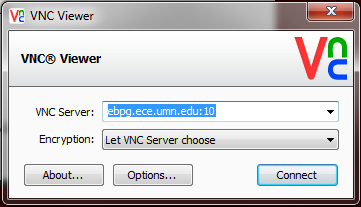 bz2 bz2 |
FileZilla_3.3.5.1_i586-linux-gnu.tar.bz2 |
manage |
4896.7 K |
10 Sep 2013 - 12:57 |
BryanCord |
|
 bz2 bz2 |
FileZilla_3.3.5.1_i686-apple-darwin9.app.tar.bz2 |
manage |
5001.5 K |
10 Sep 2013 - 12:58 |
BryanCord |
|
 exe exe |
FileZilla_3.3.5.1_win32-setup.exe |
manage |
4151.6 K |
10 Sep 2013 - 12:55 |
BryanCord |
|
 3-Linux-x64 3-Linux-x64 |
VNC-Viewer-5.0.3-Linux-x64 |
manage |
3143.8 K |
10 Sep 2013 - 12:55 |
BryanCord |
|
 3-Linux-x86 3-Linux-x86 |
VNC-Viewer-5.0.3-Linux-x86 |
manage |
2997.1 K |
10 Sep 2013 - 12:55 |
BryanCord |
|
 dmg dmg |
VNC-Viewer-5.0.3-MacOSX.dmg |
manage |
2044.1 K |
10 Sep 2013 - 12:58 |
BryanCord |
|
 exe exe |
VNC-Viewer-5.0.3-Windows-32bit.exe |
manage |
2713.9 K |
10 Sep 2013 - 12:57 |
BryanCord |
|
 exe exe |
VNC-Viewer-5.0.3-Windows-64bit.exe |
manage |
3419.9 K |
10 Sep 2013 - 12:57 |
BryanCord |
|
 exe exe |
putty-0.60-installer.exe |
manage |
1718.0 K |
10 Sep 2013 - 12:56 |
BryanCord |
|
 Log into the VNC server using the format (server_name):(display) in the 'Server' field, where server_name is
Log into the VNC server using the format (server_name):(display) in the 'Server' field, where server_name is  Set up a new session with the following settings (everything else can be left at default):
Host Name:
Set up a new session with the following settings (everything else can be left at default):
Host Name:  The left side shows the local system (your computer) and the right side shows the remote system (the computer you're connected to). You can quick-connect to a server by entering the host, username, password, and port in the boxes along the top of the window, but click the upper-left button to set up a permanent, reusable connection profile. Doing this will bring up the following dialog:
The left side shows the local system (your computer) and the right side shows the remote system (the computer you're connected to). You can quick-connect to a server by entering the host, username, password, and port in the boxes along the top of the window, but click the upper-left button to set up a permanent, reusable connection profile. Doing this will bring up the following dialog:
 Click the 'New Site' button to set up a new connection profile with the following settings:
Host Name:
Click the 'New Site' button to set up a new connection profile with the following settings:
Host Name: